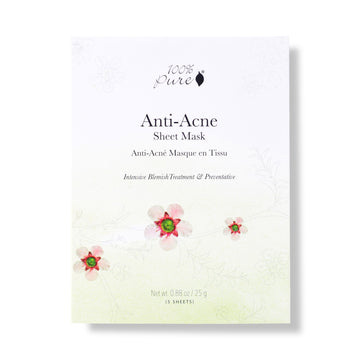When an acne mask isn’t the answer, here’s what to use instead
Written by: 100% PURE ®
Buyer beware: acne treatments are never a one-size-fits-all solution.
A single pimple pops up, and you’re ready to load up on multi-step treatments, acids, and face masks. While it’s tempting to reach for the strongest acne-fighting product first, ask yourself: do I really need it?
If you’re prone to dry skin for example, it’s very likely that breakouts haven’t been a big issue throughout your skin care journey. As such, you wouldn’t need to bust out say, a super potent acne face mask just to purge one pimple. Perhaps a spot treatment, or a more thorough cleansing routine might do the trick.
We all go through periods of breakouts and the occasional irritation, but this doesn’t always call for a full acne treatment. An over-the-top approach may actually exacerbate irritation! It’s important to understand that your skin will undergo cycles – so if you’re getting the occasional blemish or two, don’t stress.
Without further ado, let’s go over the times when you do want a face mask for acne, and what to use instead when you don’t.

If your skin’s on the drier side, you can still experience hormonal changes that can lead to breakouts – especially during periods of stress. Still, this probably doesn’t mean you need an entire face mask for acne management. In fact, it might actually be detrimental to your skin’s microbiome.
Our skin produces sebum in order to keep skin healthy and hydrated. It also works as a barrier against harmful bacteria. This is one of the main ways acne masks work: by reducing the sebum levels in your skin. For some individuals, this is helpful – but for dry skin types, it’s not.
When the oil levels in our skin are depleted, our bodies can read this as a sign to make more sebum, and possibly lead to bigger acne problems overall. So if your skin is on the normal-to-dry side, we don’t really recommend a full face mask for acne treatment. Instead, employ a spot treatment to target pimples as they arise.
What to use for dry skin
Our Tea Tree Concentrated Spot Treatment uses the power of antimicrobial and antifungal botanicals to help fade existing blemishes. Witch hazel helps balance oil production in the skin, while tea tree oil helps restore pH balance in the skin barrier while clearing the pores of impurities.
All you need is a few drops, but if you feel like you’re experiencing a pattern of regular breakouts, advancing to a mask may be helpful. In this case, it might be best to stick to something gentle and hydrating, like our Anti-Acne Sheet Mask. This mask combines witch hazel and willow bark with aloe vera and vegetable glycerin.

If your skin ranges from shiny to greasy throughout the day – or if makeup tends to slide off your skin – there’s a good chance that you have an oily/acne-prone skin type.
Those with oily or acne-prone skin may experience frequent breakouts well into their 30s and 40s. Women with this skin type may also find themselves more prone to hormonal acne during their periods. Hormonal acne is especially a bother for some, as it can be quite painful and difficult to conceal.
If any of this sounds familiar, you’re not alone! According to one study, around 12-22% of American women suffer from adult acne. That’s compared to the 4-6% of men.
That being said, those with acne-prone skin may benefit from incorporating a face mask for acne into their regimen every 2 weeks, after they’ve cleansed and toned their skin. Those with a case of hormonal acne caused by stress or menstruation may benefit from an additional face mask during flare ups.
What to use for oily/acne-prone skin
For regularly treating acnegenic skin, our powder cleansers can work beautifully as a face mask for acne. Our Lavender Oat Milk Soothing Cleanser is helpful for those with particularly irritated skin as it contains colloidal oatmeal, coconut milk, and lavender to calm the skin and reduce redness.
The Pore Detox Herbal Cleanser is well suited for cystic acne that suffers from painful inflammation. This is thanks to its purifying yet gentle ingredients like coneflower, dandelion, green clay, and neem. Simply add water to your powder formula of choice, and apply to cleanse skin. Leave it on for about 10 minutes before rinsing off.
For the occasional hormonal breakout, we recommend our Tea Tree Deep Detox Mask. This is our most potent face mask for acne, designed to detoxify and refine the pores with some of the best-known ingredients for the job.
In addition to tea tree, this mask also contains salicylic acid – found in willow bark – and works wonders for unclogging congested pores. Salicylic acid is a beta-hydroxy acid; BHAs are great for acne-prone skin because they gently exfoliate the pores on a molecular level to help reduce acne.
In this mask, you’ll also find French green clay, which draws toxins out of the skin like a magnet while reducing surface oil. Azelaic acid, which is derived from grains, helps the skin reduce existing redness while helping to prevent breakouts in the future.
We carefully hand-select products based on strict purity standards, and only recommend products we feel meet this criteria. 100% PURE™ may earn a small commission for products purchased through affiliate links.
The information in this article is for educational use, and not intended to substitute professional medical advice, diagnosis, or treatment and should not be used as such.

















